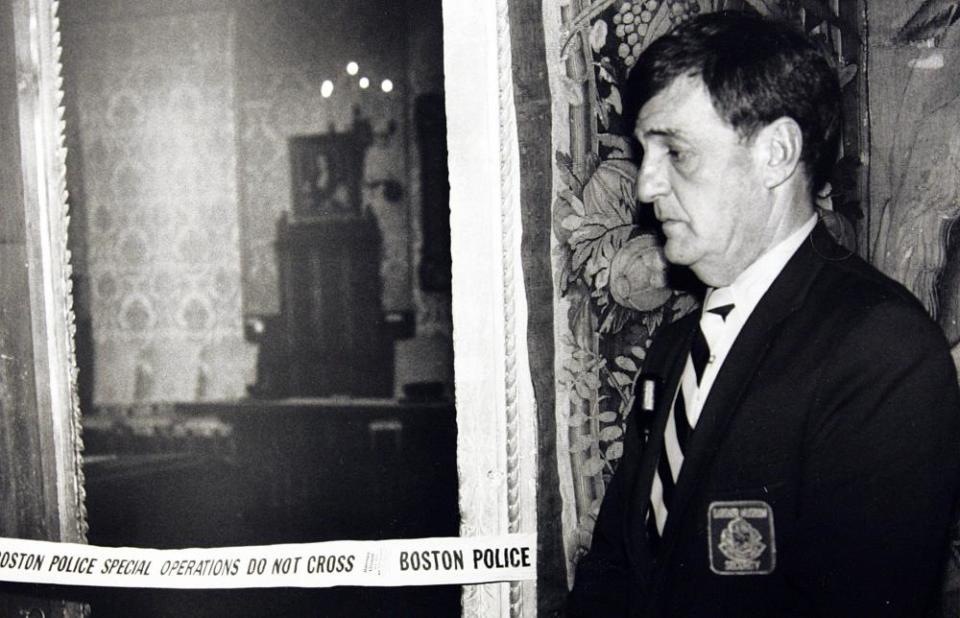Will Boston's $500m art heist ever be solved?

On 18 March 1990 two police officers entered the Isabella Stewart Gardner Museum in Boston – they told security they were responding to a late-night disturbance and asked to be let in. The guard allowed the cops in through the employee entrance but got a surprise – they were art thieves. After handcuffing the two guards, they stole 13 famous artworks by Rembrandt, Vermeer and Degas, walking away with art today valued at $500m.
It remains the world’s biggest unsolved art heist and the museum announced last week that they are extending a $10m reward for art stolen 28 years ago. According to Steve Kidder, president of the museum’s board, the museum doubled the reward and made it indefinite because they remain hopeful that the art will make a comeback.
“This reward demonstrates the commitment of the museum and its board of trustees to the recovery of these important works,” Kidder said in a statement. “We are the only buyer for these works and they belong in their rightful home.”
The artworks stolen include Rembrandt’s Christ in the Storm on the Sea of Galilee, as well as his A Lady and Gentleman in Black. Johannes Vermeer’s The Concert was also stolen, as was Govert Flinck’s Landscape with an Obelisk. When one walks into the museum today, the empty picture frames hang where the masterpieces were once displayed.
Anthony Amore is the museum’s security chief, who is working full-time on the investigation with an FBI agent. He says they have had an overwhelming number of calls over the past six months. “Doing security at the museum is my job but solving this case is my life,” said Amore. “The problem is not the volume, it’s the quality of calls. A lot of people contacted me with their theories, but I tell them we’re not looking for theories but facts.”
Among many theories, some say it was a mafia job, others think the security on duty were on the side of the criminals. In 2015, the Guardian’s Jonathan Jones asked: “Is America’s greatest art heist about to be solved?” citing a security video released by the police showing a rehearsal of the robbery the previous day. The role of one security guard, then 23-year-old rock musician Richard Abath, who could have been part of the heist, is also questioned.
Another theory is that the job was carried out by two criminals, one named Myles Connor, a rock guitarist imprisoned for an art heist in 1975, who came forward to offer the art’s return in 1997 through an associate named William Youngsworth. A reporter from the Boston Herald was invited to see the stolen art that year in a Red Hook warehouse, but its authenticity was questioned and Youngsworth was later ruled out as a suspect.

The FBI has said the stolen artworks were on sale in Philadelphia in the early 2000s, and that the heist was done by a criminal organization based in the mid-Atlantic and New England area, identifying one of two suspects as Boston gangster Bobby Donati, who died in a gang war in 1991.
Arthur Brand, a Dutch investigator and art adviser based in Amsterdam, claims the art is in Ireland.
“The FBI have been in Ireland many times because they’ve had strong leads for the art being in hands of the Irish Republican Army, but some people think they’re still in America,” said Brand. “Now they’re focusing on Robert Gentile, a mafia member who is 80 years old who was offered jail-free if he offered the paintings back. Does the FBI really think he wouldn’t make a deal if he knew anything? Gentile said he didn’t know where the art is, but the FBI is still focusing on that man.”
Brand is still working on leads in Ireland. “I have spoken to former IRA members who say it was common knowledge these paintings were probably in hands of the organization,” he said. “One said, ‘I heard we had them.’”
He encourages people who have access to the paintings to reach out to him. “I am independent and I can make sure if someone comes forward, they remain anonymous, but nobody has come forward,” said Brand. “It’s complicated. It’s a strange case.”
Boston gangster Louis Royce said he was still owed 15% for devising the heist plan, according to Pulitzer Prize-winning writer Stephen Kurkjian, who wrote a book on the robbery called Master Thieves: The Boston Gangsters Who Pulled Off the World’s Greatest Art Heist. Royce went to jail for another crime.
Melanie Hall, the director of the museum studies program at Boston University, says that the heist has helped museums increase their security.
“Since 1981, the American Alliance of Museums has spearheaded a museums assessment program to assist mid-size museums in improving operations and meeting standards,” she said.
But Hall believes the focus should be on returning the art where it belongs – to the public. “For now, I would be more interested in seeing the works returned for young people to enjoy, rather than knowing exactly what happened,” she said. “That will be something for future sleuths to figure out.”
In light of the indefinite reward money, the museum is releasing a book called Stolen on 10 April, which offers an inside look at the robbery with commentary from the museum director, curators and security. Amore, who has been working on the case for 12 years, thinks they could be close to solving the case.
“We are looking for that one or two pieces of info that could end this for us,” said Amore. “Someone could call with the info for one last puzzle piece.”

 Yahoo News
Yahoo News 
